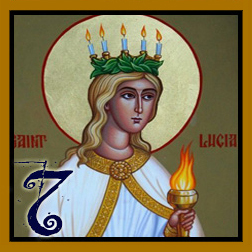The Sixth Square: Sinterklaas / Krampusnacht / St. Nicholas's Day & Bodhi Day
 Sinterklaas / Krampusnacht (December 5th) / St. Nicholas Day (December 6th)
Saint Nicholas
Sinterklaas / Krampusnacht (December 5th) / St. Nicholas Day (December 6th)
Saint Nicholas, also called Nikolaos of Myra, was a historic 4th-century Christian saint and Greek Bishop of Myra, in Asia Minor (modern-day Demre, Turkey). Because of the many miracles attributed to his intercession, he is also known as Nikolaos the Wonderworker. His legendary habit of secret gift-giving gave rise to the traditional model of Santa Claus, through the Dutch
Sinterklaas. Saint Nicholas is the patron saint of everybody from sailors and merchants to archers, repentant thieves, children, brewers, pawnbrokers and students in various cities and countries around Europe. The best-known legend associated with him is his secret nightly gift of money to a pauper whose daughters would have had to remain unmarried if their father had not been able to pay their dowry. According to one version of the legend, in order to remain undetected, St. Nicholas dropped the final bag of gold down the chimney. According to another one, the daughter who was the intended recipient had washed her stockings that evening and hung them over the embers to dry, and that the bag of gold fell into a stocking. – Gifts that children find in their shoes (or stockings) on Sinterklaas / St. Nicholas Day include tangerines, walnuts, chocolates and cookies.

In German and parts of Central European folklore, St. Nicholas has a companion variously known as
Knecht Ruprecht or
Krampus. While Knecht Ruprecht is a human, Krampus is a horned, anthropomorphic figure, half-goat, half-demon, possibly of pre-Christian origin. During the Christmas season, this companion punishes children who have misbehaved, in contrast with Saint Nicholas, who rewards the well-behaved with gifts. Children can avoid punishment by, inter alia reciting a short piece of memorized poetry to St. Nicholas as a sign of good behavior.
The Reading Tasks:
Read a story involving children or a young adult book, or a book with oranges on the cover, or whose cover is primarily orange (for the Dutch House of Orange) –OR– with tangerines, walnuts, chocolates, or cookies on the cover.
–OR–
Other Tasks:
Write a witty or humorous poem to St. Nicholas –OR– If you have kids, leave coins or treats, like tangerines, walnuts, chocolate(s) and cookies [more common in Germany] in their shoes to find the next morning and then post about their reactions/bewilderment. ;) If you don’t have kids, do the same for another family member / loved one or a friend.
 Bodhi Day (December 8th)
Bodhi Day (December 8th)
Bodhi Day is the Buddhist holiday that commemorates the day that the historical Buddha, Siddhartha Gautama, experienced enlightenment, also known as bodhi in Sanskrit and Pali. According to tradition, Siddhartha – an ascetic born as a prince in the Northern part of the Indian Subcontinent, in an area today partly in Nepal and partly in Bihar and Uttar Pradesh (India) – had recently forsaken years of extreme ascetic practices and resolved to sit under a peepal tree and simply meditate until he found the root of suffering, and how to liberate oneself from it. As the morning star rose in the sky in the early morning of the third watch of the night, Siddhartha finally found the answers he sought, became enlightened, and experienced Nirvana (in Buddhist belief, the ultimate state of release from the cycle of birth-and-pain-and-death). As a result, he became a Buddha or Awakened One.
The Reading Tasks:
Read a book set in Nepal, India or Tibet, –OR– which involves animal rescue. (Buddhism calls for a vegetarian lifestyle.)
–OR–
Other Tasks:
Perform a random act of kindness. Feed the birds, adopt a pet, hold the door open for someone with a smile, or stop to pet a dog (that you know to be friendly); cull your books and donate them to a charity, etc. (And, in a complete break with the Buddha’s teachings, tell us about it.) –OR– Post a picture of your pet, your garden, or your favourite, most peaceful place in the world.




















